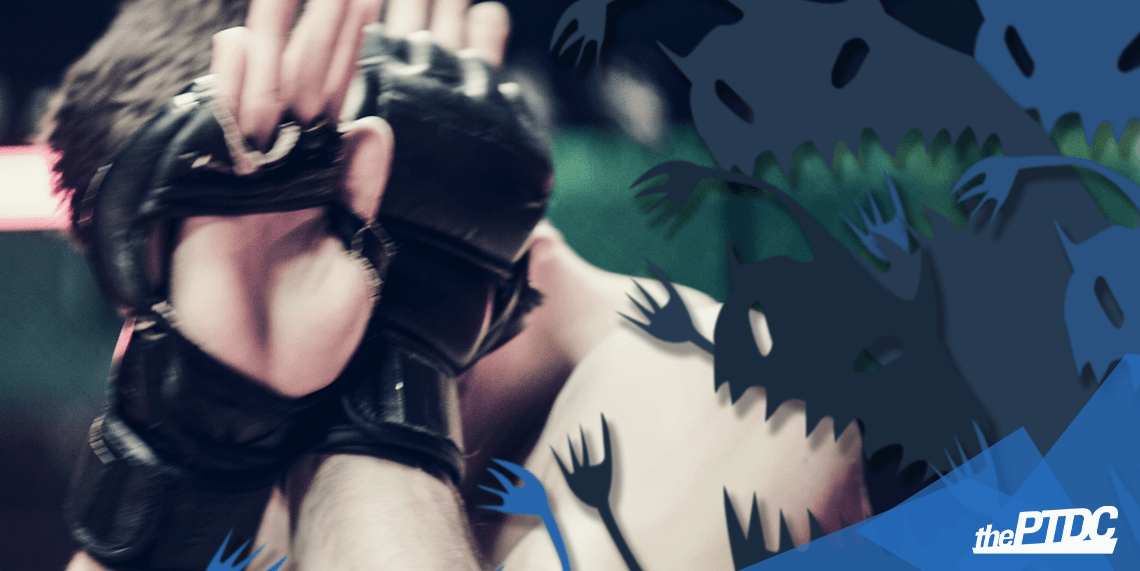I owe much of my success to my education—in a pub.
I spent most of my first 20 years of life inside the Fetherston Arms, a cozy bar and restaurant in Kirkoswald, a tidy village in Cumbria, in the north of England.
My parents ran the place, my mum cooking in the back and my dad out front, having a chin-wag with the villagers coming off work or the hikers passing through.
Fireplace, stone walls and dartboard, meat pies and pints—you get the picture.

The Fetherston Arms, a pub in the north of England, half an hour from the Scotland border, in the Lake District, is better known for inspiring poets (Wordsworth, Coleridge) than producing personal trainers.
Nothing in that picture seems to suggest my future as one of the U.K.’s top trainers, with athletes and celebrities among my clientele.
Or as founder of the Advanced Coaching Academy, where thousands of trainers have learned how to create their own fitness businesses.
But look closer …
There’s my dad, pulling pints and greeting guests, making everyone feel welcome, able to start a conversation with anyone. I absorbed that “soft skill,” which is essential in the fitness business.
There’s both my mum and dad, working long hours every single day, including Christmas Eve and Christmas Day. Hard work is equally essential.
As an adult the work ethic I inherited from my parents kicked in big time.
Now, at 43, when I talk with trainers hoping to start their own business, I hear (and see in their eyes) some of the apprehension I faced when starting out.
In my experience, most fitness business owners share a few common fears. Let me share what I’ve learned along the way, and unconsciously in the pub, to help you overcome some of those fears that may be holding you back.
Fear #1: “What if I can’t do this?”
Fear of failure is totally understandable. It affects nearly everyone to some degree.
Accept it as part of the process. And look at it like a trainer: Muscles pushed to failure will grow bigger and stronger.
Once I accepted that I’d be pushing myself to failure along the way, I started to lose that irrational fear of progression.
If I made a mistake, I learned to work that mistake.
- I learned to plan better,
- be more prepared,
- and execute more precisely.
It’s a bit odd for trainers to fear failure, because we expect our clients to fail at some moves.
And we don’t let them get discouraged.
Fear #2: “This is going to be a huge change.”
Well, yeah.
Fear of success is another top fear of fitness business owners. Which is a hard concept to grasp, so again, look at it from your experience as a trainer.
Take weight-loss clients. I believe that many of them are frightened of the end result, odd as that sounds.
Think about it—someone in their 40s, say, who is overweight, has probably lived most of their adult life as a heavy person. Their entire demeanor, character, lifestyle, behaviors, social circle—it’s all been as a heavy person.
They may be terrified of losing that life, even if it was unhealthy. They may self-sabotage their program—we’ve all seen this, right? Their friends might tease them and say they don’t need to change.
It’s like the “gate fever” that can grip someone coming out of prison. It’s well documented—they’re frightened of leaving a familiar setting. Scared of what’s on the other side.
My experience tells me that many trainers felt insecure at some point in their lives, maybe as an adolescent or young adult. Felt that they didn’t belong. They wanted to feel better about themselves, and so they started training.
That feeling is deeply rooted. And it can re-emerge in your career as a feeling that you don’t deserve success. One version of this is the “impostor syndrome,” where you feel like a fraud.
Remember that we’ve all been through this. And that you just have to look at the thousands who’ve made this leap and succeeded: It’s brilliant. You’ll love it.
Don’t sabotage yourself. Just build your business methodically, the same way you built your body, one well-executed rep at a time. You will see results.
Fear #3: “I don’t know anything about running a business!”
Neither did I. Most trainers know more about muscles than money.
But that’s okay.
Right now, someone who is thinking of leaving a gym to start their own business, in-person or online, has a wealth of resources to draw on. You’re reading one now!
Websites, business cards, T-shirts—all that stuff is beside the point. Running a business is essentially watching what money goes in versus what money goes out. That’s not a business skill, it’s a life skill you should have.
My parents did the accounting at the pub themselves, with a big red book of graph paper and a calculator. I saw it firsthand, in its simplest form.
For everyone today, the basics are out there. You can learn this stuff. Soon you’ll be talking about burn rates and acquisition costs like a real pro.
Don’t take basic accounting lightly because you think it’s a secondary skill, or because it’s unappealing.
I’ve consulted with businesses where I’ve asked to see their books, and everything is rounded up or rounded down. No! Those rounding errors can mean the difference between failure and success. Be precise.
We trainers are great at tracking numbers for clients. If you can track volume on the gym floor, you can track income. Workout sheet or balance ledger—same idea.
It’s work, yeah? But you love what you do, or you wouldn’t be reading this.
That makes it easier to work hard, to coin a phrase. Hard work is most of the battle. The rest is the soft skill of communication.
Fear #4: “I’m pretty comfortable right now. Why risk my steady paycheck?”
I hear you. That’s more fear talking. Moving from one comfortable life to an uncertain life can seem foolhardy.
You’ll need some real self-knowledge here. I’ve met many people who’ve left a stressful profession to go into coaching at a gym because they see it as an easy career option—it’s something they love to do.
That alone won’t cut it if you’re going off on your own. Going to that next level means asking yourself:
Can I manage that increased workload?
Can I manage my home life and a business?
Can I handle a job where the paychecks stop when I take a holiday?
Only you can answer those questions.
While you ponder that, here’s something to consider. We coaches are dedicated to improving the quality of someone’s life, right? We help clients live healthier lives.
Apply the quality-of-life test to your situation. Say you gave up your steady paycheck and began working the hours you want, in the place of your choice, with more time for family. Isn’t your quality of life going to be better?
We’re led to believe that the key to quality of life is more money. So you work more but spend less time on things you enjoy. That doesn’t improve your quality of life.
The beautiful part is that even if there’s a dip in your income when you go out on your own, there’s also a good chance that it’ll quickly start to climb. And there’s a huge potential upside.
But I also know that it’s easier to say that than to do—especially when you need that entire paycheck to pay the rent and buy the groceries.
So balance the optimism with realism when starting out. Make sure you have a commitment from clients before heading out on your own.
If, for instance, you’re assuming that your client Mary will follow you from the big commercial gym to your new private studio, stop assuming that. She may also like the tennis courts and swimming pool and social scene at the big gym.
You need that financial commitment from your clients up front, in advance.
Related: Don’t forget to calculate your Freedom Number, the minimum monthly income you need to meet your needs.
Fear #5: “I’m worried about finding clients.”
Good. Because that should be your number-one priority.
If you can’t acquire new customers, you’re shot. You can have the sharpest business mind around, but without clients, you’re done.
You can do this. It’s down to communication. This is where I shine, thanks to those 20 years at the pub, watching my dad.
It’s a dying art, one of the soft skills that aren’t really taught enough. Master it and you’ll stand out.
My dad could start a conversation with a farmer or a barrister or a backpacker. Find the smallest thing you have in common—anything you can relate to—and you’re off and running, building a rapport.
Back at the pub, music was a constant—I grew up listening to music from the 60s through the 90s. I know more than I should about every era. So there’s one way into conversation—what’s playing in the gym, or in their earbuds. Try any subject:
Music.
Television.
Sport.
Clothes.
Weather.
One thing not to do is come up to someone and tell them what they’re doing wrong. Early on, I had an instructor tell me to do just that. I suppose unsolicited exercise tips could be helpful to some, but it’s more likely to turn someone off.
It’s more important to find that tiny thing in common—that song, that team, that food—and you’ll always have that connection. It’s the best kind of client acquisition you’ll ever have.
Do this: Force yourself to develop your conversational skills. Give yourself a goal of approaching, say, five strangers a day. See if you can find something in common within 60 seconds—doesn’t matter how tenuous the connection is.
This will pay off. It’s just arithmetic!
Beyond acquisition, your conversational skills will help you create a bond with clients. They’ll be more likely to follow your instructions, see good results, and stay loyal. And they’ll recommend you to others.
Maybe it’ll help to think of my parents in the pub—you have to charm people and work hard. That makes most of your other business fears quite manageable.
Fear #6: “I’m a good one-on-one trainer, but can I make this work online?”
This shouldn’t be a fear now. Not after the growth in online training of the past 10 years—and then the surge in remote coaching during the pandemic.
A lot of people have stopped going to the gym. It’s now universally acceptable to exercise at home.
We’ve got a massive opportunity as coaches to do our work online—for anyone, in any country.
But you need to tweak your communication skills, make it all visual and verbal because you can’t be physically with the client. (And you’ll have to work a bit on your tech skills, finding the best camera angles. That’ll come.)
You’ll need to vocalize every movement. For instance, the squat—what cues will work best during an online session? Maybe for a hip hinge, it’s “imagine sitting on a high bar stool,” or “pretend you’re closing your car door with your bum.”
Going online is merely a migration of skills, with slight tweaks. But one thing it definitely requires is a deep understanding of the exercises—the progressions a client can handle, or the regressions they might benefit from.
You’re not there in person. You can’t see everything. So your extensive knowledge of the exercises and potential pitfalls is important.
Going online makes some things easier, but your expertise remains essential.













